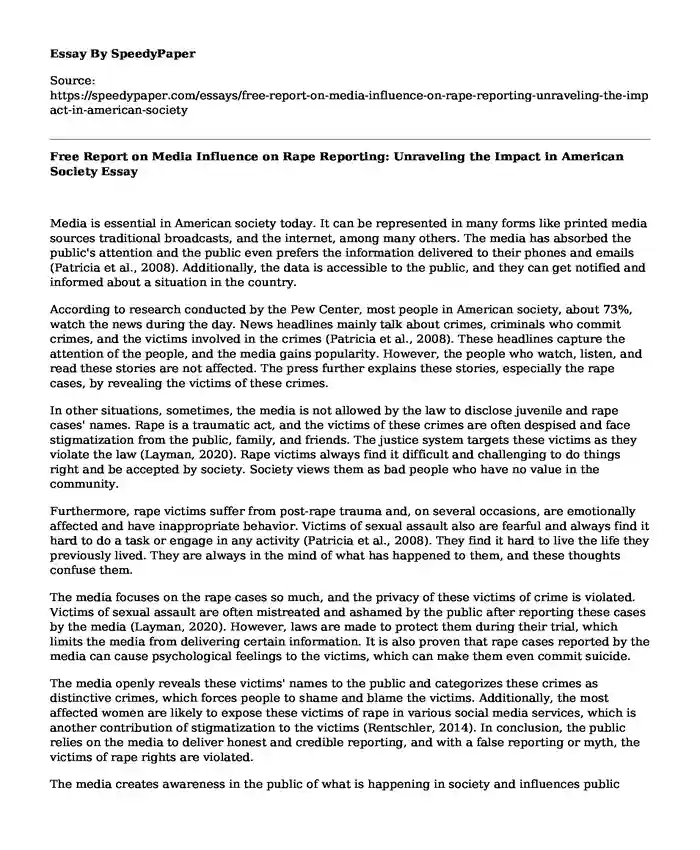
| Type of paper: | Essay |
| Categories: | United States Media Society |
| Pages: | 3 |
| Wordcount: | 730 words |
Media is essential in American society today. It can be represented in many forms like printed media sources traditional broadcasts, and the internet, among many others. The media has absorbed the public's attention and the public even prefers the information delivered to their phones and emails (Patricia et al., 2008). Additionally, the data is accessible to the public, and they can get notified and informed about a situation in the country.
According to research conducted by the Pew Center, most people in American society, about 73%, watch the news during the day. News headlines mainly talk about crimes, criminals who commit crimes, and the victims involved in the crimes (Patricia et al., 2008). These headlines capture the attention of the people, and the media gains popularity. However, the people who watch, listen, and read these stories are not affected. The press further explains these stories, especially the rape cases, by revealing the victims of these crimes.
In other situations, sometimes, the media is not allowed by the law to disclose juvenile and rape cases' names. Rape is a traumatic act, and the victims of these crimes are often despised and face stigmatization from the public, family, and friends. The justice system targets these victims as they violate the law (Layman, 2020). Rape victims always find it difficult and challenging to do things right and be accepted by society. Society views them as bad people who have no value in the community.
Furthermore, rape victims suffer from post-rape trauma and, on several occasions, are emotionally affected and have inappropriate behavior. Victims of sexual assault also are fearful and always find it hard to do a task or engage in any activity (Patricia et al., 2008). They find it hard to live the life they previously lived. They are always in the mind of what has happened to them, and these thoughts confuse them.
The media focuses on the rape cases so much, and the privacy of these victims of crime is violated. Victims of sexual assault are often mistreated and ashamed by the public after reporting these cases by the media (Layman, 2020). However, laws are made to protect them during their trial, which limits the media from delivering certain information. It is also proven that rape cases reported by the media can cause psychological feelings to the victims, which can make them even commit suicide.
The media openly reveals these victims' names to the public and categorizes these crimes as distinctive crimes, which forces people to shame and blame the victims. Additionally, the most affected women are likely to expose these victims of rape in various social media services, which is another contribution of stigmatization to the victims (Rentschler, 2014). In conclusion, the public relies on the media to deliver honest and credible reporting, and with a false reporting or myth, the victims of rape rights are violated.
The media creates awareness in the public of what is happening in society and influences public perceptions (Layman, 2020). They also affect what action the public should take on a given report or story and who is to be blamed. The stories are categorized into two frames; the episodic frame and the thematic frame. The episodic structure talks about an isolated incident while the thematic frame organizes a border context situation. The serial frame causes the public to sympathize with an individual story, while the thematic mainly describes statistical data.
The episodic framing of most rape cases influences the view and reaction of the public. If the media, some of the media's vocabulary influences public judgment about an individual (Layman, 2020). A word like accuser results in the public sympathizing rather than using the word victim. Some of these rape cases are sometimes myths, and victims are accused of the crime they did not commit. The media should conduct an investigation and clarification before reporting a story. In my opinion, the media reporting, the information from various articles, and the daily newspapers should only write and convey a story based on facts to avoid shaming individuals who are viewed as sexual assaulters. However, some of these reports are essential to give to the public to enable them to take caution.
References
Layman, K. E. (2020). The Representation of Rape and Sexual Assault within News Media. 5(22), 1-8.
Patricia, Grant, & Paula, O. (2008). The mass media and the victims of rape.
Rentschler, C. A. (2014). Rape Culture and the Feminist Politics of Social Media. 7(1), 65-82.
Cite this page
Free Report on Media Influence on Rape Reporting: Unraveling the Impact in American Society. (2024, Jan 04). Retrieved from https://speedypaper.com/essays/free-report-on-media-influence-on-rape-reporting-unraveling-the-impact-in-american-society
Request Removal
If you are the original author of this essay and no longer wish to have it published on the SpeedyPaper website, please click below to request its removal:
- Ethics and Social Justice Essay, Free Example
- Essay Example on Street Gangs Recruitment and How It Mirrors Terrorist Recruitment
- Free Essay Sample on the Impact of Mass Media on American Sport
- Why Does Welfare State Matter? Essay Example
- Free Essay on Montana: The Best Bet to Survive a Virus Outbreak
- Article Analysis Essay on Incumbency, National Conditions, and the 2012 Presidential Election
- Essay Sample on Feminism Theory and Fairy Tales
Popular categories




